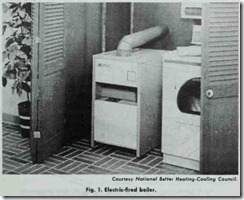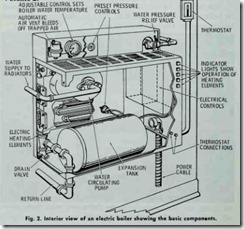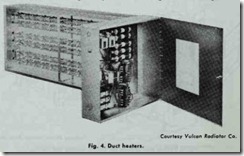There are a variety of different types of heating systems that use electricity as a source of heat. Each of them will employ one or more of the following methods of heat transfer:
1. Radiation,
2. Convection,
3. Forced air.
Radiation is the transmission of heat energy by means of electromagnetic waves. In other words, the heat is transferred directly from the surface of the heating element to the people, objects, and furnishings in the room without heating the air. The air will pick up a certain amount of heat from these surfaces (i.e. the bodies of the people, the furnishings, etc.) which then circu lates by natural convection.
With convection, the temperature of the air is increased by contact with a heated surface. The air rises as it becomes warmer (and lighter), resulting in a circulation of the air in the space. Now note the difference between radiation and convection. In the radiation method of heat transmission, the heat energy passes through the air to the individual or object in much the same way that the sun transfers its heat. The air is not used as the medium of heat transfer. The surfaces are warmed and the air picks up heat from these surfaces (convection), not directly from the heat energy passing through it.
In the forced air method of heat transmission, the heated or conditioned air is circulated by motor-driven fans integral to the heating unit or included elsewhere in the system. The heated air is forced directly into the room from the heating unit as in the case of a wall heater) or through a duct system from a centrally located furnace (central forced warm air heating systems).
CENTRAL HOT WATER SYSTEMS
Some central hydronic systems (i.e. forced hot water heating systems) use electric-fired boilers as the heat source. These boilers (Fig. 1) are compact units consisting of an insulated steel or cast iron generator with replaceable immersion heating ele ments. The expansion tank, circulating pump, valves, and pre wired controls are included within the boiler package, and the entire unit is assembled at the factory (Fig. 2).
The water (sometimes other liquids are used) is heated in the boiler and forced through the pipes by the water circulating pump to baseboard convectors or radiators located in the various rooms.
The controls for an electric boiler are similar to those found on boilers (e.g. oil-fired, gas-fired, etc.) in other types of central heating systemrs. The basic controls are:
1. A low-voltage thermostat,
2. Pressure and temperature limit controls,
3. Relay and sequence controls,
4. Circulating pump control.
The circulating pump is activated by the low-voltage thermo stat. Boiler overheating and pressure build-up is controlled by the boiler high limit controls and the pressure-temperature relief valve.
A more detailed description of electric-fired boilers and their controls is found in other chapters of this book (see, for example, the section on electric-fired boilers in Chapter 15. BOILERS AND BOILER FITTINGS).For information about the piping system used in electric hydronic heating, read the appropriate sections in Chapter 7 (HOT-WATER HEATING SYSTEMS), and Chapters 8 and 9, Volume 2.
Cooling for an electric hydronic system is generally provided by individual room air conditioners (i.e. through-the-wall units) or by chilled water pumped from a central refrigeration unit. The latter type installation is usually found in multifamily structures such as apartment buildings.
CENTRAL FORCED WARM-AIR HEATING SYSTEMS
Central forced warm-air heating systems that use electricity to heat or cool the air rely upon the following heat sources:
1. Electric-fired furnaces,
2. Duct heaters,
3. Heat pumps.
Regardless of the heat source, the air is circulated by fans through a duct system to the various rooms. Variations of these ducted air systems are shown in Fig. 3.
The electric-fired furnace is a complete unit designed for zero clearance, and available in several models suitable for either horizontal or vertical installation. The heat is provided by fast activating coiled wire resistance heating elements. When there is more than one coil, the individual coils are energized at intervals in sequence to prevent the type of current overload possible if all were energized simultaneously. The heating coil sequencer is activated and controlled by a low-voltage thermostat mounted on a wall in some convenient location. Overheating of the furnace is prevented by the same type of high-limit control found in other types of furnaces. The warm air is forced through the duct system to outlets in the room by a blower. Evaporator coils can be added to the furnace for cooling. Additional modifications can provide humidity control (humidification and dehumidification), ventila tion, and air filtration.
A more detailed description of electric-fired furnaces is found in Chapter 14 (ELECTRIC-FIRED FURNACES). For further information on forced warm-air heating systems, read the appro priate sections in Chapter 6 (WARM-AIR HEATING SYS TEMS). Controls for this type heating system are described in the section ELECTRIC HEATING AND COOLING CONTROLS in this chapter, and in Chapter 4, Volume 2 (THER MOSTATS AND HUMIDISTATS).
Duct heaters (Fig. 4) are factory assembled units that are installed in the main (primary) or branching ducts leading from the blower unit. Heat is provided by parallel rows of resistance wire formed in the shape of spirals, which may be sheathed or left open. The blower is housed in a specially constructed and insulated cabinet to which the ducts are connected. This unit functions as the power source for circulating the air through the duct heater and the rest of the system. Cooling can be provided by adding a cooling unit to the blower. Humidity control is possible by first supercooling the air in the coil and then reheating it to the desired temperature and moisture content when it passes through the duct heater.
Some duct heaters are designed to be inserted into a portion of .the duct through a hole cut in its side, and are more or less permanent units. Other duct heaters are assembled at the factory in a portion of duct which is flanged for easy installation at the site.
Duct heaters may be installed in more than one duct to provide zoned heating. When this is the case, each duct heater is provided with means for independent temperature control. An other common method is to install a single duct heater in the main (primary) duct leading from the blower unit. Controls for either type installation are similar to those used on electric-fired furnaces (see above).
The third type of heat source used in ducted central forced warm-air heating systems is the air-to-air or water-to-air heat pump. These are briefly described in another section of this chapter (see ELECTRIC HEAT PUMPS), and in greater detail in Chapter 12, Volume 3 (HEAT PUMPS).
RADIANT HEATING SYSTEMS
Any electrical conductor that offers resistance to the flow of electricity will generate a certain amount of heat; the amount of heat generated being in direct relation to the degree of resistance. This method of generating heat is employed in radiant heating systems.
The type of conductor commonly used in radiant heating systems is an electric heating cable which is imbedded in the floors, walls, or ceilings (Fig. 5). Installation of the cables may be done at the site (as is often the case with new construction),
or they may be obtained in the form of prewired, factory-assem bled, panel-type units. The heat generated by the cables is trans ferred to the occupants and surfaces in the room by low intensity radiation.
Site installed heating cables or prewired and assembled panel units are used in the following three types of radiant heating systems:
1. Radiant ceiling panel systems,
2. Radiant wall panel systems,
3. Radiant floor panel systems.Radiant ceiling heating systems are by far the most commonly used type. The other two have certain disadvantages inherent in their construction. All three types of radiant heating systems are described in greater detail in Chapter 1, Volume 3 (RADIANT HEATING).
The electric heating cables are activated and controlled by wall-mounted low voltage or line thermostats. Cooling can only be accomplished by adding a separate and independent system.
BASEBOARD HEATING SYSTEMS
Baseboard heating systems use electric baseboard units located at floor level around the perimiter of each room (Fig. 6). Each unit consists of a heating element enclosed in a thin metal housing. Zoning is possible with a single, wall-mounted line or low-voltage thermostat located in each room. Heat is provided to the room primarily by convection (some radiation is involved) as the room air moves across the heated elements in the baseboard unit. These baseboard units are described more fully in Chapter 2, Volume 3 (RADIATORS, CONVECTORS, AND UNIT HEATERS).
As is the case with radiant heating systems, cooling can be provided by installing a separate cooling system (central air or room air conditioners). The baseboard heating system represents the most widely used form of electric heating.





